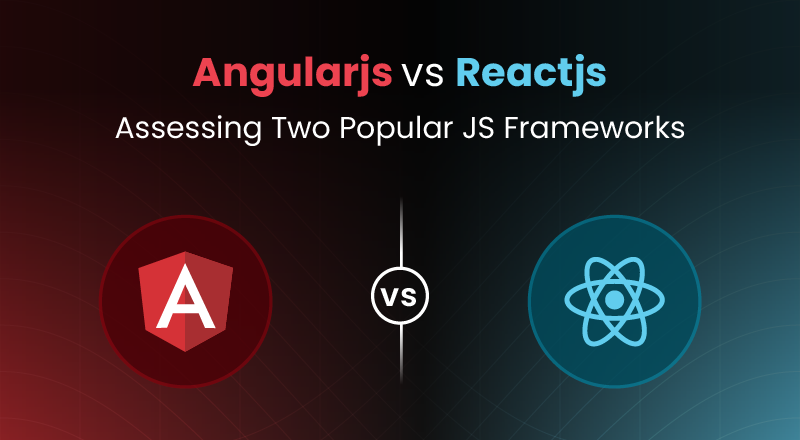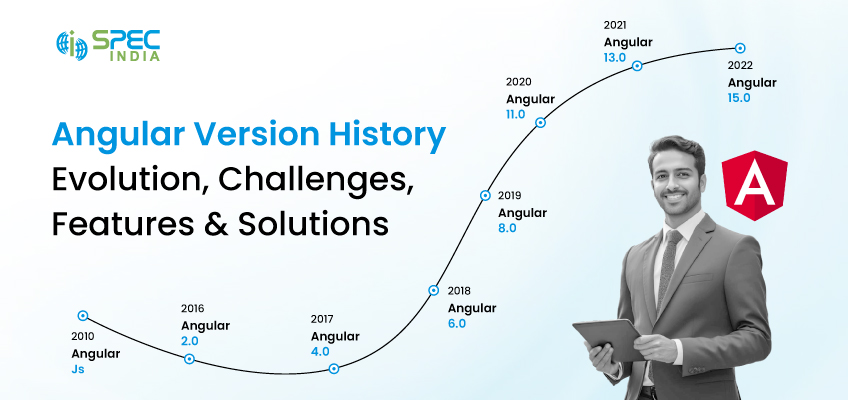Angularjs vs Reactjs: Assessing Two Popular JS Frameworks
UpdatedSeptember 22nd, 2025

Everyone is implementing robust applications utilizing enriched frameworks, ranging from startups to small, medium, and large businesses to enterprises worldwide.
One such popular framework is JavaScript, and many popular JavaScript frameworks are offered for front-end development.
Two leading names in the world of commonly compared JavaScript frameworks are Angularjs and Reactjs.
Regarding known frontend development frameworks, be it React or Angular, developers have been appreciating the goodness of both these technologies big time.
It is even more difficult for organizations to choose between the two. Angular Vs. React is an exciting evaluation that depends upon several parameters.
This article provides an overview of both technologies, their features, pros and cons, and organizations using them. It then discusses the difference between Angular and React through a parameter-based comparison matrix. It also emphasizes situations indicating when to use which—React or Angular.
What is Angularjs?
AngularJS is a well-known open-source JavaScript-based application framework for dynamic web app development. It leverages HTML as the template language and changes static HTML into dynamic HTML. It generates an environment that is easy to understand, fast to develop, and communicative.
Powered by Google and built on TypeScript, it has been a leading, fully featured, client-side framework for creating high-performing web and mobile apps. As a structural framework for building dynamic web apps, it offers enterprise-ready web app development solutions with component-based architecture and dynamic, single-page web apps, too.
There is a vast collection of integrated libraries and features such as routing, two-way data binding, dependency injection, and client-server communication that speed up web development. There are practical developer tools that are best fit to develop small to enterprise-grade applications.
Transform Your Business with AngularJS Innovation
What is Reactjs?
ReactJS is a powerful open-source frontend JavaScript library that offers development companies excellent features for developing exclusive interfaces and experiences for high-performance solutions. Its scalability, adaptability, and flexibility help developers streamline the frontend development process and offer reliable React development services.
React showcases a component-based architecture and declarative views that help developers build fast, complicated, and interactive user interfaces seamlessly. Powered by Facebook, it follows the ‘learn once, write anywhere’ fundamental and makes the code easy to understand and operate.
React empowers developers to create user interfaces from reusable UI components. It uses server-side rendering for a flexible, performance-driven solution. It promotes a component-dependent architecture with modular and self-contained components, faster development, easy maintenance, and reusability of the logical part.
Reactjs vs. Angularjs – Key Features
Salient Features of React-
- Virtual DOM and declarative views
- JSX advantage with the flexibility to build blocks
- Isomorphic JavaScript
- Code stability with one-way data binding
- Simplicity and time-saving
- Rapid development and enhanced user experience
- Component-based architecture
Salient Features of Angular
- Two-way data binding and dependency injection
- Inbuilt libraries and support for AJAX, HTTP
- Angular CLI and virtual scrolling
- Enhanced error handling support
- Validation and forms
- Crisp and clean coding style
- UI and business logic split
Angularjs vs Reactjs – Pros and Cons
Advantages of Angular JS
- Easy maintainability, testing, and updates
- Faster server-side rendering
- Interactive user interface with data binding
- Single routing option
- Enhanced developer productivity and performance
- Fewer lines of code owing to parallel components
- A material design like an interface
- Strong encapsulation and intuitive app structure
- Seamless updates with Angular CLI
Benefits of React JS
- Reusability with predictable coding
- Faster development with easy debugging
- Increased developer productivity and load time
- Flexibility to build blocks with single data binding
- Seamless integration with third-party libraries
- Easy to learn with a simplistic design
- Faster and effective migration
- Quicker updates on the server side and frontend support
- HTML-like syntax facilitates templating and documentation
Limitations of Angular.js
- Steep learning curve
- Tough to integrate with third-party libraries
- Documentation is challenging to understand
Limitations of React.js
- Integration with traditional MVC is tough
- Lack of updated documentation
- Lack of support for SEO activities
Craft Exceptional User Interfaces with ReactJS
Angular js vs. React js – Organizations Using Them
Companies Using Angular
Apple, Microsoft, Google, PayPal, Beam, Mesh, AWS, Telegram, GoPro, WePay, Forbes, UpWork, Delta, Santander, Samsung, Mixer, Deutsche Bank, etc.
Companies Using React
Netflix, Walmart, Asana, Facebook, Pinterest, Dropbox, Slack, Airbnb, Yahoo, Skype, Instagram, Myntra, Wix, Discord, The New York Times, Uber, etc.
Angular vs. React – Key Similarities
- High-performing JavaScript frameworks
- Extensive support for web app development
- Open-source, frontend libraries
- Creation of a view from data based on tools
- Client-side and server-side rendering
- Accommodates scalable development
AngularJS vs ReactJS: Detailed Comparison
| Parameters |
Angular |
React |
| Overview |
An open-source framework for the creation of dynamic web apps, a part of the MEAN stack, compatible with code editors |
An open-source library for the creation of user interface components, used to develop reusable HTML elements for frontend development |
| Developed By |
Google |
Facebook (Meta) |
| Year of Release |
2009 |
2013 |
| Written in |
TypeScript |
JavaScript |
| Type of Technology |
MVC structured framework |
JavaScript library |
| Performance |
High-performance framework as it uses real DOM and two-way data binding |
High-performance library as it uses virtual DOM and runs on a single-directional data flow |
| Data Binding |
Two-way data binding (bidirectional) – Guarantees that the model state automatically changes when any change is made. |
One-way data binding (unidirectional) – UI elements cannot be altered without updating the corresponding model state |
| Learning Curve |
It has a steep learning curve, with a complex component management system |
It has a moderate learning curve and empowers faster application development |
| Best Suitable For |
Interactive, dynamic, and highly active enterprise web applications, complex enterprise apps, progressive web apps, and single-page apps |
Large apps with continuously differing data, UI components, modern web apps, natively rendered hybrid apps, social networking apps, and eCommerce apps |
| User Interface Components |
Material Design components to ease out user interface creation |
Material-UI library & dependencies to offer UI components |
| Testing Types |
Supports both unit and integration testing |
Supports only unit testing |
| Dependency Injection |
Fully supported, automatic management of dependencies |
Not endorsed, needs extra tools for management of dependencies |
| DOM Type |
Real DOM |
Virtual DOM |
| Frontend Development Criteria |
HTML functionality extension with client-side rendering |
Makes use of JSX, with a preference for server-side rendering |
| App Structure |
Fixed, complex, component-based framework |
Flexible, component-based |
| Usage of Libraries |
It is a complete solution in itself |
It can be packaged with other libraries |
| Community Support |
Dependable community support |
Not much community support |
| Code Complexity |
Simple, easy-to-understand code |
Tad difficult and complex code |
| App Architecture |
MVC |
Flux |
| Time of Installation |
Easy to set up, but can increase coding time when needed |
Longer to set but faster in delivery |
| Testing Tools |
Testing and debugging can be done through a single tool and built-in functionalities |
Testing and debugging need different types of tools, like Redux, to test apps and log data |
| Language Preference |
TypeScript |
JSX – JavaScript XML |
| Abstraction |
Medium |
Strong |
| GitHub Stars |
80.8K |
180K |
| Fork |
48.2K |
30.3K |
| Rendering |
Client-side rendering |
Server-side rendering |
| Packaging |
Weak packaging |
Strong packaging |
| Routing |
Uses a template or control for manual router configuration |
Uses several modules for router configuration |
| Migration |
Easy to upgrade/migrate because of enhanced CLI feature with built-in commands |
Easy to upgrade/migrate through reliance on external libraries, with a check on compatibility |
Angular vs. React – When to Choose What?
It is a tough call to make on which to choose and when, as we compare AngularJS vs React. Here is a simple guideline that offers situations that can be referred to while selecting the technology:
You can choose AngularJS when:
- There is a need to create feature-rich, enterprise-level apps
- The application complexity level is from low to medium
- It would be best if you created apps like video streaming apps, eCommerce apps, real-time data apps, and content-based apps
- You are looking at a robust and well-defined framework
- The phase of the project is in the start phase, with the need for a complete framework
- You need to develop web apps with different architectures and environments
- There is a need for dynamic web apps wherein user content will keep changing
You can select ReactJS when
- There is a need for a customized or personalized application
- The application needs multiple events or shareable components
- It would be best if you created apps like cross-platform mobile apps, messaging apps, eCommerce apps,and social media apps
- There is a need to expand the app functionality in the future
- You have dynamic content that can alter the business needs in the future
- The code has grown complicated, and you need to handle it
- There are continuous complaints of unresponsiveness
Good Read: Angular vs React vs Vue: Which is the Best Choice?
Angular or React: Summing It Up
It is a challenging task to choose between two frontend frameworks that are highly competitive and efficient. That is the case as we compare AngularJS vs ReactJS. To each their own! Some organizations may find Angular better, and some may find React better. Based on the criteria mentioned above, you can decide between the two.
Overall, when evaluating Angularjs vs. React, both come out as winners and have tremendous support from the community. Other external parameters, such as project requirements, complexity levels, availability of skilled resources, business objectives, costing and efforts, budget estimates, etc., play a crucial role in determining the technology.
We have a team of highly skilled, efficient, and experienced ReactJS Developers who are equipped with the right skills and in-depth knowledge of React fundamentals to deliver SPAs, PWAs, static site generation, social media apps, dynamic web pages, and more with an assurance of on-time project delivery.
Hire a skilled React developer from us. We have trained and experienced ReactJS developers who are ready to extend your team. Our developers are proficient in extensive ReactJS development and have experience building feature-rich frontend and web app solutions.
As one of the leading AngularJS development companies, SPEC INDIA has garnered extensive expertise and experience in developing and implementing comprehensive AngularJS development services across many industry domains worldwide.
Hire a dedicated AngularJS developer from us. Our AngularJS developers have proven their skills by creating widespread AngularJS websites and mobile apps with supreme quality within stipulated timelines.
Frequently Asked Questions
AngularJS is often preferred for large-scale applications due to its built-in features like dependency injection and two-way data binding, which can simplify complex applications. However, ReactJS can also be used for large applications when combined with additional libraries and tools.
ReactJS uses a virtual DOM to efficiently update only the necessary parts of the actual DOM, resulting in better performance. AngularJS's two-way data binding can lead to more frequent updates, potentially affecting performance in large applications.
ReactJS follows a component-based architecture where UIs are built as a tree of reusable components. AngularJS also uses components, but its architecture is more opinionated, involving controllers, services, and directives within an MVC structure.
Both AngularJS and ReactJS have active and large communities. ReactJS, being a library, may have a more diverse ecosystem with various third-party libraries, while AngularJS offers a more integrated solution.
React provides a more lightweight and flexible approach to building user interfaces. Its one-way data binding and virtual DOM contribute to better performance and simpler debugging in large applications.
SPEC INDIA is your trusted partner for AI-driven software solutions, with proven expertise in digital transformation and innovative technology services. We deliver secure, reliable, and high-quality IT solutions to clients worldwide. As an ISO/IEC 27001:2022 certified company, we follow the highest standards for data security and quality. Our team applies proven project management methods, flexible engagement models, and modern infrastructure to deliver outstanding results. With skilled professionals and years of experience, we turn ideas into impactful solutions that drive business growth.






